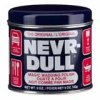Guys,
A good number of you restore Ordnance, by removing rust and corrosion, etc. Taking in mind that most of these items are steel, aluminum, copper washed steel, some plastics, etc. What are the current methods you are using to remove corrosion without damaging the parent metal? Here in the U.S., there has been mention of using electrolysis with a lye solution to remove rust, specifically from Civil War cannon balls, and then putting them in distilled water to pull the salts out, if the ball was exposed to seawater. I've seen oxalic acid mentioned on this site for cleaning.
What methods and chemicals are you guys using, that doesn't destroy parent metal, plastics, etc.?
Thanks,
John
A good number of you restore Ordnance, by removing rust and corrosion, etc. Taking in mind that most of these items are steel, aluminum, copper washed steel, some plastics, etc. What are the current methods you are using to remove corrosion without damaging the parent metal? Here in the U.S., there has been mention of using electrolysis with a lye solution to remove rust, specifically from Civil War cannon balls, and then putting them in distilled water to pull the salts out, if the ball was exposed to seawater. I've seen oxalic acid mentioned on this site for cleaning.
What methods and chemicals are you guys using, that doesn't destroy parent metal, plastics, etc.?
Thanks,
John





